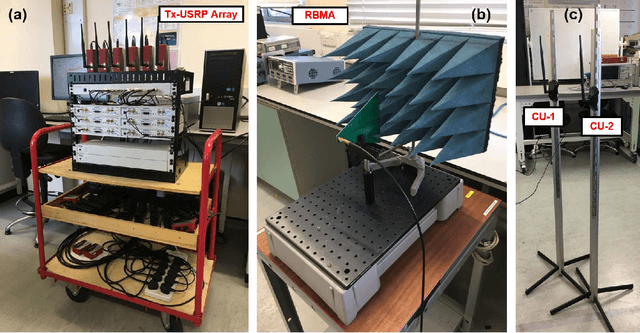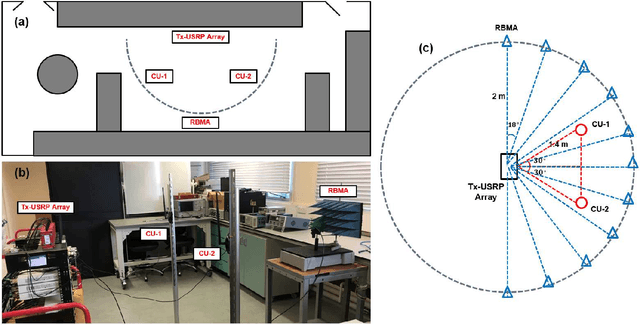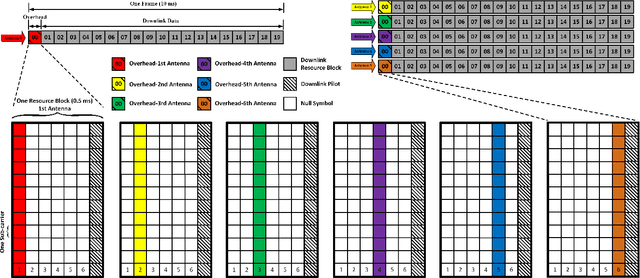Izzat Darwazeh
Synchronous Clock and RF Carrier Transmission for Radio Access Network Fronthaul
Jun 06, 2025Abstract:We simultaneously achieve clock synchronisation, clock-synchronised data transmission and ultra-low noise RF carrier generation by combining clock phase caching and frequency comb transmission in radio access networks (RAN). We demonstrate <100fs jitter for 25GHz RF carrier and 2.5GHz clock, and 16-hour 6.6ps RMS wander.
Dual band wireless transmission over 75-150GHz millimeter wave carriers using frequency-locked laser pairs
Oct 27, 2023

Abstract:We generate and transmit 75-GHz-bandwidth OFDM signals over the air using three mutually frequency-locked lasers, achieving minimal frequency gap between the wireless W and D bands using optical-assisted approaches, resulting in 173.5 Gb/s detected capacity.
Index Modulation Pattern Design for Non-Orthogonal Multicarrier Signal Waveforms
Apr 18, 2022



Abstract:Spectral efficiency improvement is a key focus in most wireless communication systems and achieved by various means such as using large antenna arrays and/or advanced modulation schemes and signal formats. This work proposes to further improve spectral efficiency through combining non-orthogonal spectrally efficient frequency division multiplexing (SEFDM) systems with index modulation (IM), which can efficiently make use of the indices of activated subcarriers as communication information. Recent research has verified that IM may be used with SEFDM to alleviate inter-carrier interference (ICI) and improve error performance. This work proposes new SEFDM signal formats based on novel activation pattern designs, which limit the locations of activated subcarriers and enable a variable number of activated subcarriers in each SEFDM subblock. SEFDM-IM system designs are developed by jointly considering activation patterns, modulation schemes and signal waveform formats, with a set of solutions evaluated under different spectral efficiency scenarios. Detailed modelling of coded systems and simulation studies reveal that the proposed designs not only lead to better bit error rate (BER) but also lower peak-to-average power ratio (PAPR) and reduced computational complexity relative to other reported index-modulated systems.
An Experimental Proof of Concept for Integrated Sensing and Communications Waveform Design
Feb 09, 2022



Abstract:The integration of sensing and communication (ISAC) functionalities have recently gained significant research interest as a hardware-, power-, spectrum- and cost- efficient solution. This experimental work focuses on a dual-functional radar sensing and communication framework where a single radiation waveform, either omnidirectional or directional, can realize both radar sensing and communication functions. We study a trade-off approach that can balance the performance of communications and radar sensing. We design an orthogonal frequency division multiplexing (OFDM) based multi-user multiple input multiple output (MIMO) software-defined radio (SDR) testbed to validate the dual-functional model. We carry out over-the-air experiments to investigate the optimal trade-off factor to balance the performance for both functions. On the radar performance, we measure the output beampatterns of our transmission to examine their similarity to simulation based beampatterns. On the communication side, we obtain bit error rate (BER) results from the testbed to show the communication performance using the dual-functional waveform. Our experiment reveals that the dual-functional approach can achieve comparable BER performance with pure communication-based solutions while maintaining fine radar beampatterns simultaneously.
Deep Learning for Over-the-Air Non-Orthogonal Signal Classification
Nov 14, 2019



Abstract:Non-cooperative communications, where a receiver can automatically distinguish and classify transmitted signal formats prior to detection, are desirable for low-cost and low-latency systems. This work focuses on the deep learning enabled blind classification of multi-carrier signals covering their orthogonal and non-orthogonal varieties. We define two signal groups, in which Type-I includes signals with large feature diversity while Type-II has strong feature similarity. We evaluate time-domain and frequency-domain convolutional neural network (CNN) models in simulation with wireless channel/hardware impairments. Simulation results reveal that the time-domain neural network training is more efficient than its frequency-domain counterpart in terms of classification accuracy and computational complexity. In addition, the time-domain CNN models can classify Type-I signals with high accuracy but reduced performance in Type-II signals because of their high signal feature similarity. Experimental systems are designed and tested, using software defined radio (SDR) devices, operated for different signal formats to form full wireless communication links with line-of-sight and non-line-of-sight scenarios. Testing, using four different time-domain CNN models, showed the pre-trained CNN models to have limited efficiency and utility due to the mismatch between the analytical/simulation and practical/real-world environments. Transfer learning, which is an approach to fine-tune learnt signal features, is applied based on measured over-the-air time-domain signal samples. Experimental results indicate that transfer learning based CNN can efficiently distinguish different signal formats in both line-of-sight and non-line-of-sight scenarios with great accuracy improvement relative to the non-transfer-learning approaches.
 Add to Chrome
Add to Chrome Add to Firefox
Add to Firefox Add to Edge
Add to Edge